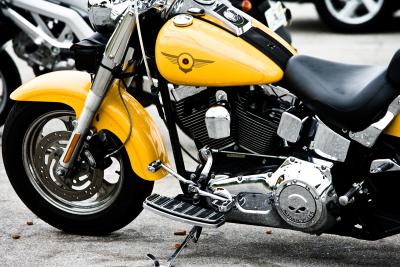
Motorcycles typically come with parts made from aluminum or aluminum alloy. Such parts include wheel rims, draft tubes, carburetor bodies, engine, clutch and transmission cases, rocker panels and other "dressy" or exposed parts and covers. Aluminum alloy has lightweight and strong characteristics, but it can corrode and pit, losing its luster and aesthetic appeal. Aluminum is subject to oxidation, chemical contamination and road salts, which can form a white crust. White crust actually is deteriorated and detached aluminum. A motorcycle owner can fix his aluminum corrosion problems by using some special products and tools, and following some basic repair and refinishing steps.
Stabilize the motorcycle on its kickstand, or utility kickstand, on a concrete surface that has good drainage. Use a high-pressure water nozzle to wet the bike, covering all aluminum surfaces. Use a mild dish-washing soap, bucket and detailing brush to clean the aluminum surfaces, removing all road grime -- mud, oil and dirt. Thoroughly rinse the parts with clean water. If the aluminum parts have been removed, clean them individually, rinse and dry with a clean terrycloth towel.
Look for aluminum parts that have clear-coat paint coverings. If the corrosion exists in the paint, you must remove the clear-coat paint before proceeding. Use masking tape to mask off the areas in proximity to the aluminum that you wish to keep from paint stripper contact; paint stripper degrades paint, rubber and plastics.
Don a particle mask and gloves. Use a paintbrush to apply a thick coat of paint stripper, then let it sit according to directions -- generally five to 15 minutes. Rinse with high-pressure water and dry with cloth towels.
Fill a bucket with clean water and stir in a cap-full or two of dish-washing soap. Use 400-grit wet sandpaper over the most corroded spots on the aluminum parts by dipping the sandpaper in the bucket and applying circular motions over the metal. Work in the sandpaper until you have smoothed out the deepest pits. Frequently wet and change the sandpaper to keep it from loading up. Use a rubber sanding block over the flattest surfaces to avoid wavy lines in the surface.
Wrap a strip of wet 400-grit sandpaper around the sharpened end of a pencil; this allows you to sand the inside of recessed bolt, nut or screw holes. Be careful not to scratch bolt, nut or screw heads that have chrome coatings. Switch the sandpaper to 600-grit and sand over the aluminum parts again. Use plenty of water with the sandpaper.
Switch to 1000-grit wet sandpaper and sand all previously sanded areas. The 1000-grit should be fine enough to allow a very smooth texture. Keep the sandpaper moving in different directions, careful to remove the largest remaining scratches. Double check to make sure you have removed all white-encrusted spots over all parts of the aluminum surface. Rinse thoroughly with high-pressure water to remove all sanding silicates and residue. Dry with a clean microfiber towel.
Apply a fine abrasive aluminum polish to the aluminum surface with a thick section of microfiber towel. Use circular motions, rubbing into the surface until you have achieved a mirror-like finish. Polish small sections at a time before moving on. Frequently change out the microfiber towels. Buff the aluminum surface with the microfiber towel until no gray or black polishing residues remains. Take your time, allowing for adequate breaks. The final polishing and buffing steps recapture the original surface quality and sheen.